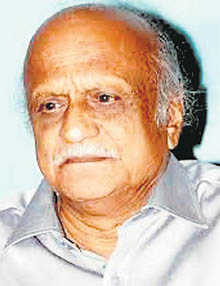
MM Kalburgi was a respected author and left-leaning ideologue. PTI
Vandana Shukla
On August 30, an unidentified person shot dead Professor M.M. Kalburgi. Kalburgi was a highly respected author and a leftist ideologue who questioned the basis of idolatry in Hinduism. He had received threats from extreme right-wing Hindu groups for questioning non-rationalist aspects of his faith. Karnataka has a tradition of celebrating and respecting outspoken scholars and writers. But with this heinous act, a new wave of intolerant India has made its presence felt in the South. Preceding Kalburgi's murder, a pack of trident-wielding youths had celebrated the death of Jnanpith Award winner, famous Kannada writer U R Ananthamurthy, using venomous language against him. Ananthamurthy was a co-traveller of Kalburgi in the campaign for rational thought.
When a society starts repackaging its past glory into a collective, disruptive pathological disorder, it should suggest it has failed to infuse new ideas and thoughts. It can only be termed as particularly a sad development for Indian society, which has been enriched by its long tradition of enquiry and debate and assimilation of diverse thoughts and cultures. The murder of its celebrated scholars sounds the deathknell of India's social evolution. One wonders, if the Hindu Renaissance of the late 19th century would have succeeded, had it not been for the British, who strictly imposed the reformist ideas initiated by the rational thinkers of the Brahmo Samaj and Arya Samaj. Ironically, in a democratic India a new breed of zealots are allowed to silence their critics with guns while our democratically elected governments, committed to the ideals of secularism and freedom of thought and expression, watch helplessly.
Kalburgi's murder evokes chilling similarities with the murder of Dr Narendra Dabholkar, who was shot dead in Pune, in August 2013, by motorbike-borne unidentified men at pointblank range. Dabholkar wrote and spoke openly against age-old traditions and beliefs and tried to promote scientific temper by demanding introduction of anti-superstition bill in the Maharashtra Assembly. He reminded Hindu women of simple things like the co-relation between fasting and iron deficiency, which offended the religious sentiments of right-wing Hindu groups. Govind Pansare, a left-leaning author of the Marathi language biography of Maratha King Shivaji, Shivaji Kon Hota was also shot at in February this year in Kolhapur. The enquiry for Dabholkar’s murder was handed over to the CBI but two years have passed and the murderers have not yet been identified. Maharashtra police seems to have prioritised solving murder case of page 3 celebrities, investigating the assassination of cultural tolerance is not on their agenda.
Religious intolerance is inventing newer ploys for inciting violence across religions. One word, even though written in a lighter vein on the social media, a picture, or a cartoon is potent enough to ignite sentiments, as though waiting to explode under any pretext. In 2010, Islamic fanatics chopped off arms of T. J. Joseph, a professor of Malayalam, for inserting a text in a question paper that was based on a schizophrenic character who was talking to God. The Professor had to suffer for a few words uttered by a fictional schizophrenic, authored by someone else, for religious intolerance bred by the followers of a different faith. In this riddle, search for logic turns out to be a futile effort for a rationalist. We are living in absurd times. The modern-age killers of reason are afraid of any written word barring the scriptures — art, poetry and anything that postulates an inquiry. For the semi-literate, mostly unemployed militants, the real war is against enrichment of the mind; religion is only a decoy. It is used for its sanctity. In 2012, Sanal Edamaruku, President, Rationalists International, found the source of the “miracle” of the dripping Jesus statue in a Mumbai Catholic church as toilet drainage clogging. To “avenge” this blasphemy, professional boxers were employed to attack him outside a TV studio, where he was interviewed. He fled the country.
Now there is a new thrust on “development”. Unfortunately, the development agenda has remained limited to infrastructural development and of counting every success in fiscal terms. But “development” of a broad mental horizon seems to be absent from the official development liturgy. The crimes of murdering the mind, enjoy social and political immunity. The country has 43 devotional channels, feeding blind faith to market their line of religious product. Each channel promotes a new brand of identity constructed on superstitious beliefs and myths. None of the channels has ever been penalised for promoting superstition and igniting mass hysteria. We do not have a single channel to teach basic education in math or science to promote free enquiry. If our Constitution ensures the right to choose and promote ones' religion, it also reminds us to develop the scientific temper, humanism and the spirit of inquiry and reform (Article 51 A). A young country cannot breathe in an old body, certainly not with an old mind that harps on the glory of a mythical era gone by. If governments cannot ensure security for the voices of sanity, only insanity will prevail. It is the duty of the state governments, irrespective of their political leanings, to ensure safety of the people who develop scientific temper, humanism and the spirit of inquiry and reform in society. Any religious practice that promotes alienation of mind and reason, or promotes gender or religious bias should be questioned by our textbooks, mass media, cultural institutions, and youth icons. The famous Urdu novelist Qurratulain Hyder, wrote Aag Ka Dariya, her magnum opus that explores the vast sweep of time and history of the Indian subcontinent, moving from the fourth century BC to the post-Independence period in India and Pakistan. The long narrative moves through seamless assimilations of cultures, pausing at many crucial epochs of history. It culminates in the agony of the believers of division; of Pakistan. This agony cannot be allowed to be be repeated for the Indians of the 21st century.



























